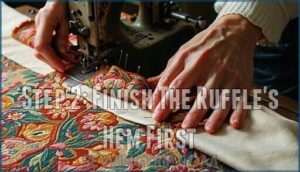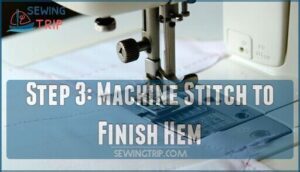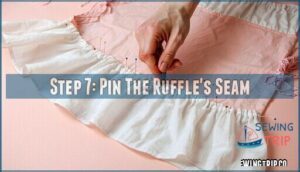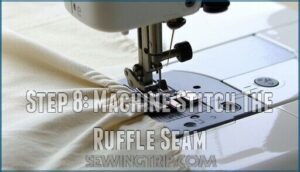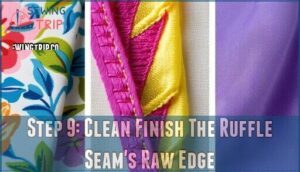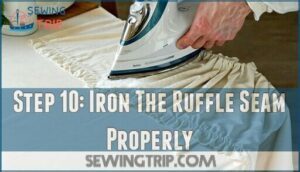This site is supported by our readers. We may earn a commission, at no cost to you, if you purchase through links.

Hem one long edge first with a narrow rolled hem or fold.
Create gathering stitches along the opposite raw edge using your machine’s longest stitch length, leaving long thread tails.
Don’t backstitch at the start or end.
Pin the ruffle to your main fabric piece, then gently pull the bobbin threads to gather the fabric evenly.
Distribute the gathers uniformly and pin securely.
Sew with a regular stitch length, then finish the seam allowance with serging or zigzag stitching.
Press the seam away from the ruffle for crisp results that’ll transform any garment into something spectacular.
Table Of Contents
- Key Takeaways
- Step 1: Prepare The Ruffle Fabric Strip
- Step 2: Finish The Ruffle’s Hem First
- Step 3: Machine Stitch to Finish Hem
- Step 4: Apply The Gathering Stitches
- Step 5: Pin The Ruffle to The Seam Before Gathering
- Step 6: Pull Basting Stitch Threads to Gather
- Step 7: Pin The Ruffle’s Seam
- Step 8: Machine Stitch The Ruffle Seam
- Step 9: Clean Finish The Ruffle Seam’s Raw Edge
- Step 10: Iron The Ruffle Seam Properly
- Frequently Asked Questions (FAQs)
- Conclusion
Key Takeaways
- Cut your fabric strip 2.5 times longer than the finished edge you’re attaching it to for ideal fullness and gathering
- Hem the ruffle’s edge first before gathering to prevent fraying and achieve a professional finish
- Create two parallel basting stitches at different distances from the raw edge, then pull both threads simultaneously for even gather distribution
- Press the seam allowance away from the gathers (never directly on them) to maintain the ruffle’s texture and create a clean, professional appearance
Step 1: Prepare The Ruffle Fabric Strip
Before diving into any ruffle tutorial, fabric preparation sets the stage for success. Start by selecting lightweight, fluid fabrics like chiffon, organza, or lace that create the best ruffle effect.
Pre-washing your chosen fabric prevents unwanted shrinkage after completing your project. For ruffle length, cut your fabric strip 2.5 times longer than the edge you’ll attach it to.
The secret to perfect ruffles? Cut your fabric 2.5 times longer than needed for ideal fullness.
This ratio delivers perfect fullness without overwhelming bulk. If you want subtle ruffles, 1.5 times works. For dramatic volume, go up to 3-4 times the measurement.
Ruffle width matters too. Cut strips 2-3 times your desired finished width since gathering reduces the apparent width. Measure twice, cut once—accurate fabric cutting saves time later.
Mark your measurements clearly and use sharp scissors for clean edges. Proper fabric preparation guarantees your sewing frills project turns out professional.
These frill techniques create the foundation for gathering fabric successfully in the following steps. Understanding ruffle gathering techniques is vital for achieving the desired fullness and texture in your project.
Step 2: Finish The Ruffle’s Hem First
Before you start gathering your ruffle, take time for proper hem preparation. This step prevents fraying and gives your finished piece a professional look.
Start by folding the raw edge of your ruffle strip toward the wrong side at 1/4 inch. Press this fold with your iron to create a crisp edge.
Next, fold the edge again at another 1/4 inch to create double-folded edges. This technique completely encases the raw fabric edge, providing excellent fray prevention. Pin the fold horizontally to keep everything in place while you work.
This double stitch approach is a cornerstone of ruffle tutorial methods because it creates durability. When sewing ruffles, hem finishing before gathering saves time and guarantees clean results.
Your gathered ruffles will look polished when the edges are properly prepared. These frill sewing tips make the difference between amateur and professional-looking work. Mastering narrow hem techniques is essential for achieving a professional finish on delicate garments.
Step 3: Machine Stitch to Finish Hem
After folding your hem in the previous step, machine stitching transforms that delicate fold into a durable, professional finish. Set your sewing machine to a straight stitch with medium stitch length and normal thread tension for ideal hem finishing.
Position the folded edge under your presser foot, keeping the fabric flat against the machine bed. Your sewing machine becomes your precision tool here, guiding the fabric smoothly without pulling or pushing, letting the feed dogs do their work.
Here’s your machine stitching checklist for perfect hem finishing:
- Set stitch length to 2.5-3mm for balanced durability and appearance
- Use matching thread color to blend seamlessly with your fabric
- Maintain consistent seam allowance, stitching close to the inner fold
- Keep steady, moderate speed to prevent puckering or stretching
- Backstitch at both ends to secure the seam finishing completely
This machine stitching creates the foundation that’ll handle all the stress once you add gathering stitches. A well-executed hem finishing prevents fraying and gives your ruffle that polished, store-bought appearance that separates amateur work from professional results. Mastering the art of hemming requires understanding key concepts like sewing machine techniques to achieve a flawless finish.
Step 4: Apply The Gathering Stitches
Now you’ll apply gathering stitches to create the foundation for your ruffle. Set your sewing machine’s stitch length to the longest setting available, typically 4-5mm. This creates loose basting threads that you can easily pull later. Reduce your thread tension slightly to prevent breakage during the gathering process.
Sew your first gathering stitch along the seam line, positioned 1/2 inch from the raw edge. Don’t backstitch at either end – you need those loose threads for gathering. Next, create a second parallel row of gathering stitches at 1/4 inch from the edge. These two rows work together to distribute gathers evenly across your fabric strip.
Keep both sets of basting threads long at each end. You’ll use these threads to scrunch your fabric into beautiful, even gathers. This gathering technique guarantees your ruffle placement creates uniform fullness rather than bunched-up fabric. The dual-stitch method provides better control during seam finishing and prevents puckering in your final frill application. For heavier fabrics, consider using three thread basting for added precision.
Step 5: Pin The Ruffle to The Seam Before Gathering
Before you can shape your ruffles into those perfect waves, you need to establish proper control over your fabric. Position your ruffle strip along the seam edge where it will be attached. Align the raw edges carefully, matching the seam allowances of both pieces.
This seam alignment creates the foundation for even gather distribution later. Use pinning techniques that secure the fabric without creating bulk. Place pins perpendicular to the edge every 2-3 inches, wrapping the loose basting threads around each pin to prevent them from getting tangled.
This fabric control method keeps everything in place while you work. For delicate fabrics, consider vertical pinning techniques to prevent distortion. Pin through both layers at the seam allowance, not through the ruffle itself. This prevents distortion and maintains the fabric’s natural drape.
The pins should penetrate just enough to hold securely without creating permanent holes. Mark quarter points on both pieces before pinning to guarantee balanced placement. This prevents shift during the gathering process and gives you reference points for even distribution across the entire seam length.
Step 6: Pull Basting Stitch Threads to Gather
With your ruffle already pinned in place, it’s time to create the magic. Grab both basting stitch threads and gently pull them together. This gathering process transforms your flat fabric strip into a dimensional ruffle.
Thread Tension control prevents breaks during pulling. Work slowly and check your progress frequently. Even Gathers require patience – rush this step and you’ll create bunched sections that look unprofessional.
Distributing Fullness evenly takes practice. Pull from both ends toward the center, then adjust spacing by sliding gathers along the threads. For Gathering Heavy Fabrics, use dental floss instead of regular thread for extra strength. One method involves zigzagging over cord for slippery fabrics.
Here’s your gathering checklist:
- Pull both threads simultaneously for balanced results
- Work from center outward for even distribution
- Check spacing every few inches during gathering
- Securing Gathers by wrapping threads around pins prevents loosening
Stop when your ruffle matches the seam length perfectly.
Step 7: Pin The Ruffle’s Seam
Now you’ve reached the pivotal moment where precision meets efficiency. With your gathers perfectly distributed, it’s time to secure them in place using proper pinning techniques.
Position pins perpendicular to the seam edge, spacing them every two to three inches along the gathered fabric. This perpendicular pinning method prevents shifting during machine stitching and maintains even gather distribution.
Perfect pinning prevents shifting and keeps your gathers beautifully even during stitching.
Insert each pin through both fabric layers, ensuring the ruffle stays aligned with the base fabric’s raw edge. The pins should penetrate cleanly without catching excess fabric underneath. Focus on securing gathers at stress points where the fabric naturally wants to bunch or spread.
Wrap the loose basting threads around the end pins to lock your gathering work in place. This securing gathers technique prevents accidental loosening while you prepare for the final seam. Generous pinning creates a stable foundation for your sewing machine work ahead; for best results, consider using a standard fullness ratio of 2:1 to 3:1, ensuring a proper pinning technique and achieving even gather distribution with perpendicular pinning and a standard fullness ratio for optimal results.
Step 8: Machine Stitch The Ruffle Seam
Now you’re ready to secure your gathered ruffle with permanent stitching. Set your sewing machine to a standard 2.5mm stitch length and select an appropriate needle size for your fabric weight.
Position the ruffle with the gathered edge facing up, ensuring you can see all the gathers clearly. Begin stitching just below your basting lines, maintaining consistent stitch tension to avoid puckering.
Guide the fabric slowly through the machine, checking that your needle catches all gathered layers without skipping stitches. The key to seam security lies in even thread distribution and proper needle choice.
Remember to use sharp fabric scissors for clean, fray-resistant edges. Remove pins just before they reach the needle to maintain alignment.
Backstitch at both ends to lock your threads securely. This permanent ruffle seam creates the foundation for your finished edge, transforming loose gathers into a professionally attached frill that won’t come undone with wear.
Step 9: Clean Finish The Ruffle Seam’s Raw Edge
Three finishing methods guarantee your ruffle seam’s raw edge won’t fray or fail over time. Serging techniques provide the gold standard for edge finishing, creating professional results in seconds while preventing 99% of fabric fraying. Your serger will cleanly trim and encase the seam allowance in one smooth pass.
Without a serger, zigzag stitching works brilliantly as your backup plan. Set your machine to a medium-width zigzag and stitch along the raw edge, allowing the right swing of the needle to catch the fabric edge. This method reduces fraying by over 90%.
For delicate fabrics, French seams offer superior seam durability by completely encasing raw edges. A clean finish method is ideal for straight seams and unlined jackets. Choose your clean finish method based on your fabric weight and available equipment. Proper fray prevention extends your garment’s life by years, making this step essential for lasting results.
Step 10: Iron The Ruffle Seam Properly
After cleaning the raw edge, proper ironing transforms your ruffle from amateur to professional. The final pressing step determines whether your ruffle looks store-bought or homemade.
Set your iron to the appropriate temperature for your fabric type. Cotton handles high heat, while synthetics need lower settings. Place a pressing cloth between the iron and delicate fabrics to prevent damage.
Here’s your ironing roadmap:
- Press the seam allowance away from the gathers, never directly onto them
- Use gentle downward motions rather than sliding the iron back and forth
- Allow the fabric to cool completely before moving to maintain the pressed shape
- Check that all raw edges lie flat and the seam creates a clean line
Focus on the seam allowance pressing technique. The iron should glide over the flat seam area while avoiding the gathered portion entirely. This gather relaxation approach prevents flattening your carefully created texture. A damp pressing cloth helps stubborn creases surrender without fabric damage avoidance becoming an issue. Your professional finish depends on this final step, and pressing seams open can reduce bulk.
Frequently Asked Questions (FAQs)
How to sew ruffles for beginners?
Transforming fabric into cascading waves of elegance starts with cutting strips 5 times your desired edge length.
Hem first, then create two basting stitches—one at seam line, another halfway.
Pull threads gently to gather evenly before pinning and stitching permanently, which involves complete concepts like gathering and stitching to achieve the desired elegance.
What are frills in sewing?
Frills are decorative fabric strips gathered along one edge and sewn onto garments or home décor items.
They add texture, movement, and feminine detail to sleeves, hems, necklines, or curtains, creating soft ruffled edges.
What fabrics work best for ruffles?
Like choosing silk for royalty’s gown, you’ll want lightweight fabrics that flow gracefully.
Chiffon, organza, and lace work best for ruffles because they gather beautifully and create elegant movement without adding bulk.
How do you calculate ruffle fabric amounts?
Multiply your finished edge measurement by 5 for the ideal ruffle strip length. You’ll need fabric that’s 2-3 times longer than where you’re attaching it for proper fullness and gathering.
Can you make ruffles without gathering?
Yes, you can create pleated ruffles instead of gathered ones.
Box pleats, knife pleats, and accordion pleats offer structured alternatives that don’t require gathering stitches or pulling threads to create fullness.
Whats the difference between ruffle types?
Single edge ruffles attach along one edge to garment hems.
Double edge ruffles gather in the middle, creating two flowing edges.
Waterfall ruffles use elastic thread for stretch at necklines.
Circular ruffles form doughnut shapes for dramatic volume.
How do you attach ruffles to curves?
Surprisingly, curves aren’t your enemy when attaching ruffles. Clip the curve’s seam allowance every half-inch, then ease the ruffle around the bend using extra pins to distribute gathers evenly.
Conclusion
Perfect ruffles cascade like gentle waterfalls down your garment, creating movement and elegance with every step.
You’ve now mastered how to frills sew using this systematic approach. Practice makes perfect—your first attempts might feel clunky, but your gathering technique will improve quickly.
Remember to cut your fabric generously for fuller ruffles. Clean finishing prevents fraying and extends your garment’s lifespan.
These skills transform basic pieces into stunning statement items that’ll turn heads wherever you go, with elegance.

